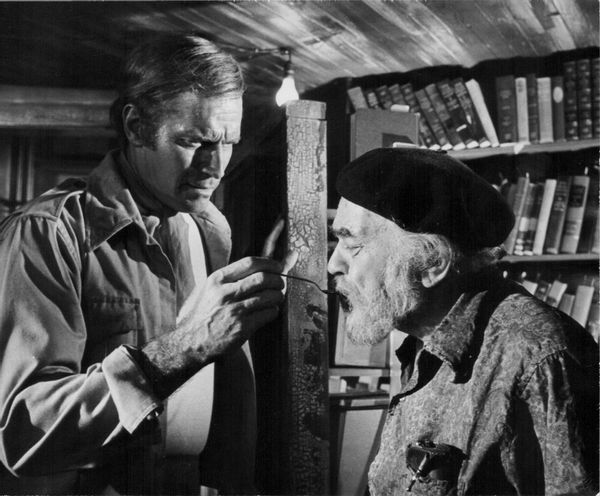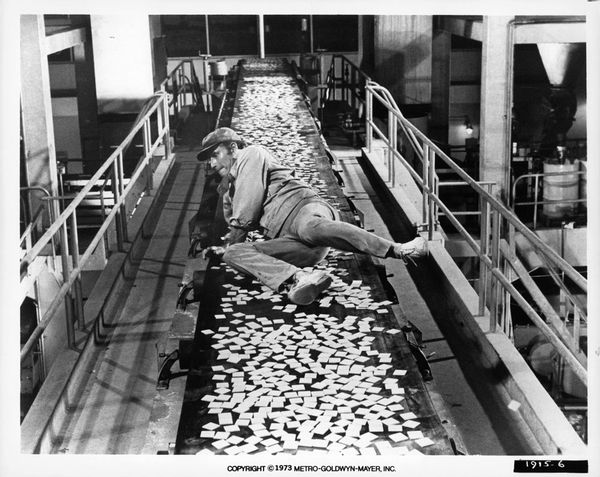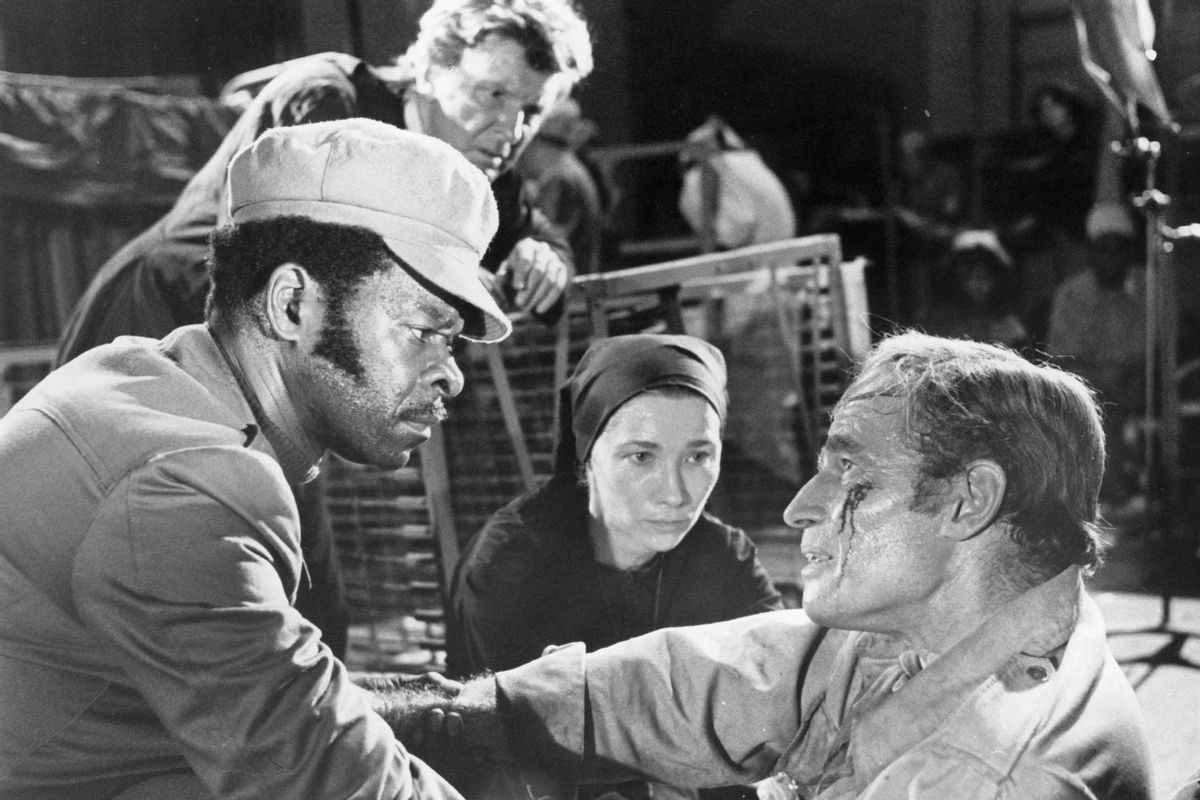A 50-year-old spoiler alert: At the end of "Soylent Green" — a classic 1973 science fiction movie directed by Richard Fleischer, written by Stanley R. Greenberg and starring Charlton Heston, Leigh Taylor-Young and Edward G. Robinson — the protagonist learns that human beings are being tricked by an evil corporation into eating human flesh. The final line of the film, which dramatically reveals this disgusting discovery, is so famous that the American Film Institute deemed it the 77th greatest movie quote of the 20th century:
"Soylent Green is people!"
When I first learned about "Soylent Green," I had no idea what the shocking ending would be. I was a 10-year-old boy in the mid-1990s; the commercialized Internet was brand new, so the days had yet to come where a quick Google or Wikipedia search could spoil all of a movie's details for impatient would-be viewers. Since I had grown up hearing about a "brilliant" twist ending for "Soylent Green" from my father, I was extremely curious to watch the movie. My mother was firmly against this, insisting that I was much too young to see such a bleak dystopian satire. I distinctly recall her warning my father with the exact words that it would be "too scary" for me. Soon I began to wield every child's most potent weapon of persuasion: A habit of politely yet persistently requesting (some might choose the word "nagging"), so that I might be allowed to watch "Soylent Green."
"Not only is the movie relevant . . . it is eerily prophetic!"
My efforts paid off. One day, when my mother and sisters were out running errands, my father and I were left home alone. With a twinkle in his eye, a sly smile on his face and barely a word of explanation uttered, my dad popped the "Soylent Green" VHS tape into our VCR and quietly watched the movie with me. Until I began the process of writing this article more than a quarter-century later, I kept that fact a secret from my mother. The main reason is that she was absolutely right: "Soylent Green" scared the ever-loving crap out of me. After I saw "Soylent Green," I became obsessively nervous that I might unwittingly consume human flesh in my food.
Yet the reason my mother was correct about "Soylent Green," ironically, is that my father was also right about the movie: "Soylent Green" was indeed one of the smartest, most thought-provoking works of social commentary that I had ever seen. Unfortunately, many scientists agree it is also terrifyingly relevant today.
Set in the year 2022, "Soylent Green" is a perfect movie for ecological awareness issues. It depicts a future world in which pollution and overpopulation have caused severe shortages in food, housing and other resources. Although "climate change" had not entered the mainstream conversation at this point, "Soylent Green" was based on a 1966 science fiction novel by Harry Harrison called "Make Room! Make Room!" that had explored how societies would deteriorate if pollution and poor natural resource management led to global starvation. (The novel, notably, did not include the cannibalism twist.)
The movie proceeds from the same premise, but focuses on one character — a grizzled, cynical cop named Robert Thorn (Heston) — as he attempts to solve the mystery behind the murder of a corporate executive named William R. Simonson (Joseph Cotten). A big clue, of course, is that Simonson works for the Soylent Corporation, which manufactures colored wafers that serve as substitutes for real food. Eventually the mystery is solved by Thorn's best friend Sol Roth (Edward G. Robinson), who discloses what he learned. That sets off a chain of violent, dramatic events that culminate in Thorn's iconic final declaration.
 Actors Edward G. Robinson and Charlton Heston in a scene from the movie 'Soylent Green', 1973. (Stanley Bielecki Movie Collection/Getty Images)Since 2022 has come and gone, and the film just turned 50 on April 19, there are plenty of commentators on hand to remark on the accuracy of how "Soylent Green" was prophetic — or, to be more precise, semi-prophetic. The Washington Post highlighted the film's predictions of varying quality about climate change (the temperature never drops below 90), assisted dying, overcrowding and even the development of video games. Mental Floss also gave the movie credit for its semi-accurate predictions about climate change, consumer good shortages and even inventions like motivational exercise bikes. CNET praises the film's astuteness in anticipating ecological catastrophes.
Actors Edward G. Robinson and Charlton Heston in a scene from the movie 'Soylent Green', 1973. (Stanley Bielecki Movie Collection/Getty Images)Since 2022 has come and gone, and the film just turned 50 on April 19, there are plenty of commentators on hand to remark on the accuracy of how "Soylent Green" was prophetic — or, to be more precise, semi-prophetic. The Washington Post highlighted the film's predictions of varying quality about climate change (the temperature never drops below 90), assisted dying, overcrowding and even the development of video games. Mental Floss also gave the movie credit for its semi-accurate predictions about climate change, consumer good shortages and even inventions like motivational exercise bikes. CNET praises the film's astuteness in anticipating ecological catastrophes.
Salon reached out to several scientists for their views on the prophetic nature of "Soylent Green." One of them, esteemed climate scientist Dr. Michael E. Mann, mentioned that he plans on referring to the movie in his upcoming book "Our Fragile Moment."
Want more health and science stories in your inbox? Subscribe to Salon's weekly newsletter The Vulgar Scientist.
"All utopian futures are alike; each dystopian future is dystopian in its own way."
"'Soylent Green' is a prescient cautionary tale not just because it was ahead of its time in predicting the climate crisis, but because of its depiction of the ruthlessness of powerful corporations willing to do anything to silence whistleblowers," Mann wrote to Salon, alluding to the brutal attempts by the Soylent Corporation to repress Simonson, Roth and Thorn as they attempt to expose the company. Dr. Ali S. Akanda, an associate professor and graduate director of civil and environmental engineering at the University of Rhode Island, reinforced Mann's observations.
"Not only is the movie relevant . . . it is eerily prophetic!" Akanda told Salon by email. He added, "It is clear we are heading for a disaster as a planet," as many parts of the world are already dealing with overcrowding and the ecological consequences of a constantly rising climate. "The coast of Bangladesh and the city of Jakarta are fighting as the sea level encroaches . . . The poles are losing the ice shelves at a rapid rate . . . Megacities like Chennai and Sao Paulo are often running out of sufficient water for its residents. I feel these movies are already here!"
Liz Costello, MPH — a PhD student at the University of Southern California who has studied PFAS, or dangerous "forever chemicals" that are in our water and food — told Salon by email that when she first saw the film last year, she was "struck by how realistic it felt, and how so many of the social and ecological issues highlighted in the film could have come from today's headlines (unfortunately). What stayed with me was the sense of helplessness and apathy in so many of the characters, and I think that's how many people feel about our environmental, political and social situation today."
Dr. Ken Caldeira from the Carnegie Institution for Science perhaps summed up all of the views most succinctly: "Dystopian futures will be forever relevant. But who can say whose dystopian future will come to pass? Paraphrasing Tolstoy, all utopian futures are alike; each dystopian future is dystopian in its own way."
 Charlton Heston slips on a conveyor belt in a scene from the film 'Soylent Green', 1973. (Metro-Goldwyn-Mayer/Getty Images)While I agree with all of these commentators' observations, I feel the need to share how my own personal experience shapes my perspective on the film.
Charlton Heston slips on a conveyor belt in a scene from the film 'Soylent Green', 1973. (Metro-Goldwyn-Mayer/Getty Images)While I agree with all of these commentators' observations, I feel the need to share how my own personal experience shapes my perspective on the film.
"'Soylent Green' is a prescient cautionary tale not just because it was ahead of its time in predicting the climate crisis, but because of its depiction of the ruthlessness of powerful corporations willing to do anything to silence whistleblowers."
As a science journalist, I regularly cover the various ways that big business hides disgusting things in our food. While I have not had to write about actual human flesh being used (yet), this by no means reduces the sheer grossness of what humans are tricked into putting into their bodies. Take fish fraud, or the widespread practice of mislabeling seafood so that consumers aren't eating what they think they purchased. In 2018, New York Attorney General Letitia James issued a report revealing that a significant percentage of the fish purchased in New York City was mislabeled, including 87% of lemon sole and 67% of red snapper fillets. She is hardly alone is raising alarm about people who buy fish literally not getting what they paid for.
"Overall, what we found is that seafood fraud can happen anywhere both geographically and in the supply chain," explained Beth Lowell, Oceana deputy vice president for U.S. campaigns, who told Salon by email in 2021 that supply chains which transport seafood from the ocean to your table are "often opaque." This, combined with pro-business government policies, makes it easy for businesses to mislead consumers. "Oceana found that nearly one out of every three fish tested in the United States — in grocery stores and restaurants alike — were mislabeled."
Fake meat problems are not limited to what we eat from the ocean; ask any of the Europeans who a decade ago learned they had unwittingly consumed horse meat that had been mislabeled as beef. Yet this issue goes beyond the realm of swapping animals for animals. One can also examine plastic pollution, which is so pervasive that nearly every human being alive regularly consumes unhealthy chemicals in their food and water. Plastic pollution – which forces humans to consume chemicals like phthalates and bisphenols — isn't merely disgusting; it is also linked to plummeting sperm counts that could render humanity infertile (a different type of dystopian crisis than the one posed in "Soylent Green," but no less sobering).
In addition, chemicals like phthalates are linked to cancer, which makes it all the more unsettling that microplastics have been detected in human blood. Even if one avoids cookware and food packaging that contains these plastics (which is effectively impossible), the planet is covered in billions of microplastics, or plastic particles less than 5 mm in length. Since these get eaten by animals and absorbed in plants through their roots, there is simply no way to avoid them.
 A poster for Richard Fleischer's 1973 science-fiction film 'Soylent Green.' (Movie Poster Image Art/Getty Images)There are also the aforementioned "forever chemicals," or PFAS (per- and polyfluoroalkyl substances). As I've covered extensively for Salon, PFAS — which are used to create water-resistant and stain-resistant coatings — enter your body through fast food wrappers, microwave popcorn bags, and nonstick cookware such as those covered with Teflon. Most people have measurable amounts of PFAS in their bodies, and these chemicals are linked to high blood pressure, liver disease and fertility problems.
A poster for Richard Fleischer's 1973 science-fiction film 'Soylent Green.' (Movie Poster Image Art/Getty Images)There are also the aforementioned "forever chemicals," or PFAS (per- and polyfluoroalkyl substances). As I've covered extensively for Salon, PFAS — which are used to create water-resistant and stain-resistant coatings — enter your body through fast food wrappers, microwave popcorn bags, and nonstick cookware such as those covered with Teflon. Most people have measurable amounts of PFAS in their bodies, and these chemicals are linked to high blood pressure, liver disease and fertility problems.
This list of "ways evil companies are messing with our food" could go on and on, covering everything from the unhygienic and environmentally disastrous conditions in factory farms to how food corporations manipulate consumers into eating more by stimulating cravings for junk food. When it comes to assessing "Soylent Green's" accuracy, though, the bottom line is clear: The movie was nauseatingly accurate in predicting that businesses would work with corrupt and/or negligent government officials to trick people into eating gross things. I may have been wrong about the exact nature of the disgusting stuff in my food, but not that it would be in there.
I suspect future culture historians will view "Soylent Green" in the same manner that they today regard the 1906 novel "The Jungle" by progressive muckraker Upton Sinclair. Although Sinclair's goal was to expose unjust working conditions in meat-packing plants to spur socialist labor reforms, his vivid depictions of unsanitary conditions instead inspired widespread revulsion. In a sense, this was a good thing, as it prompted President Theodore Roosevelt to successfully push for the passage that very same year of both the Meat Inspection Act and the Pure Food and Drug Act. (The latter led to the establishment of the Food and Drug Administration.) Yet since Sinclair's main goal had been to help workers, and not merely to create hygienic food, he later commented, "I aimed at the public's heart, and by accident I hit it in the stomach."
There is something to be said about arousing interest in justice by depicting the vomit-inducing world we might inhabit — or already inhabit — rather than appealing to conscience. In that sense, "Soylent Green" serves as an example that other social satirists may want to emulate. Its greatest attribute is not that it accurately anticipated many things about humanity's future. "Soylent Green" stands the test of time because it does these things while slamming you right where real anxiety festers and brews . . . in your guts.



Shares